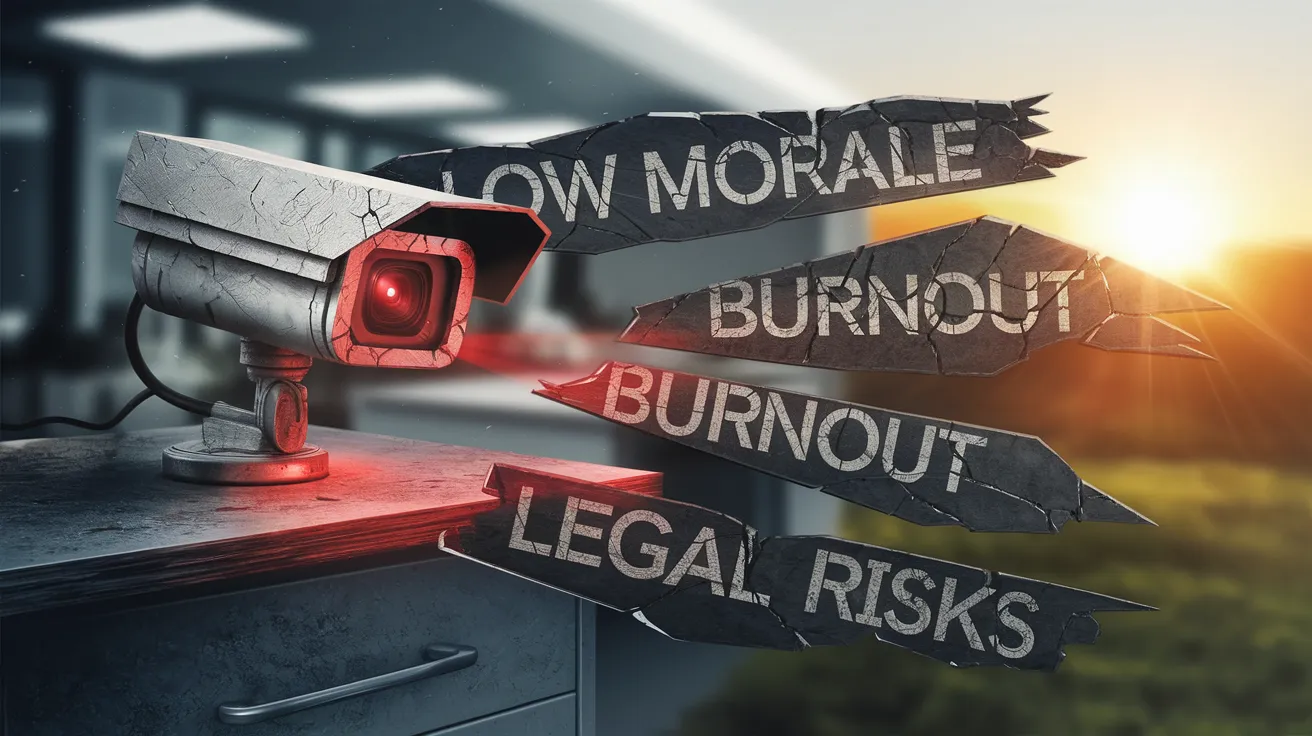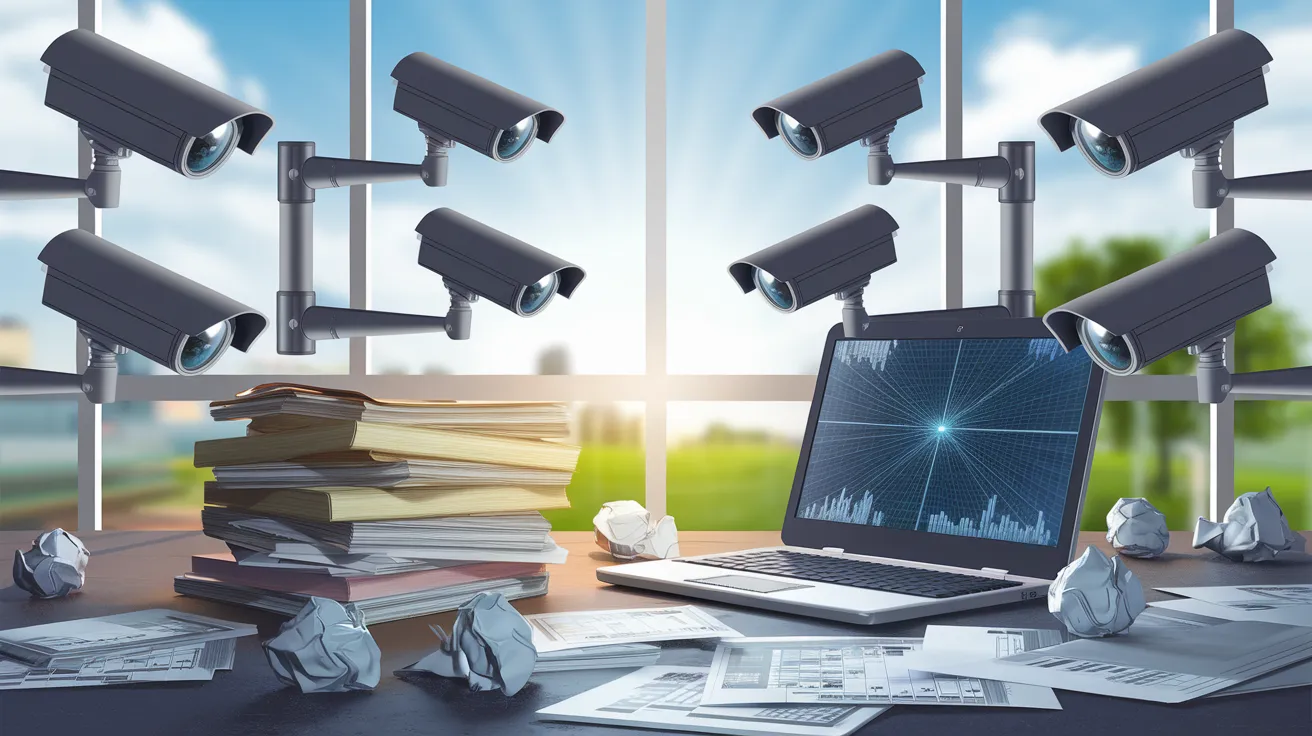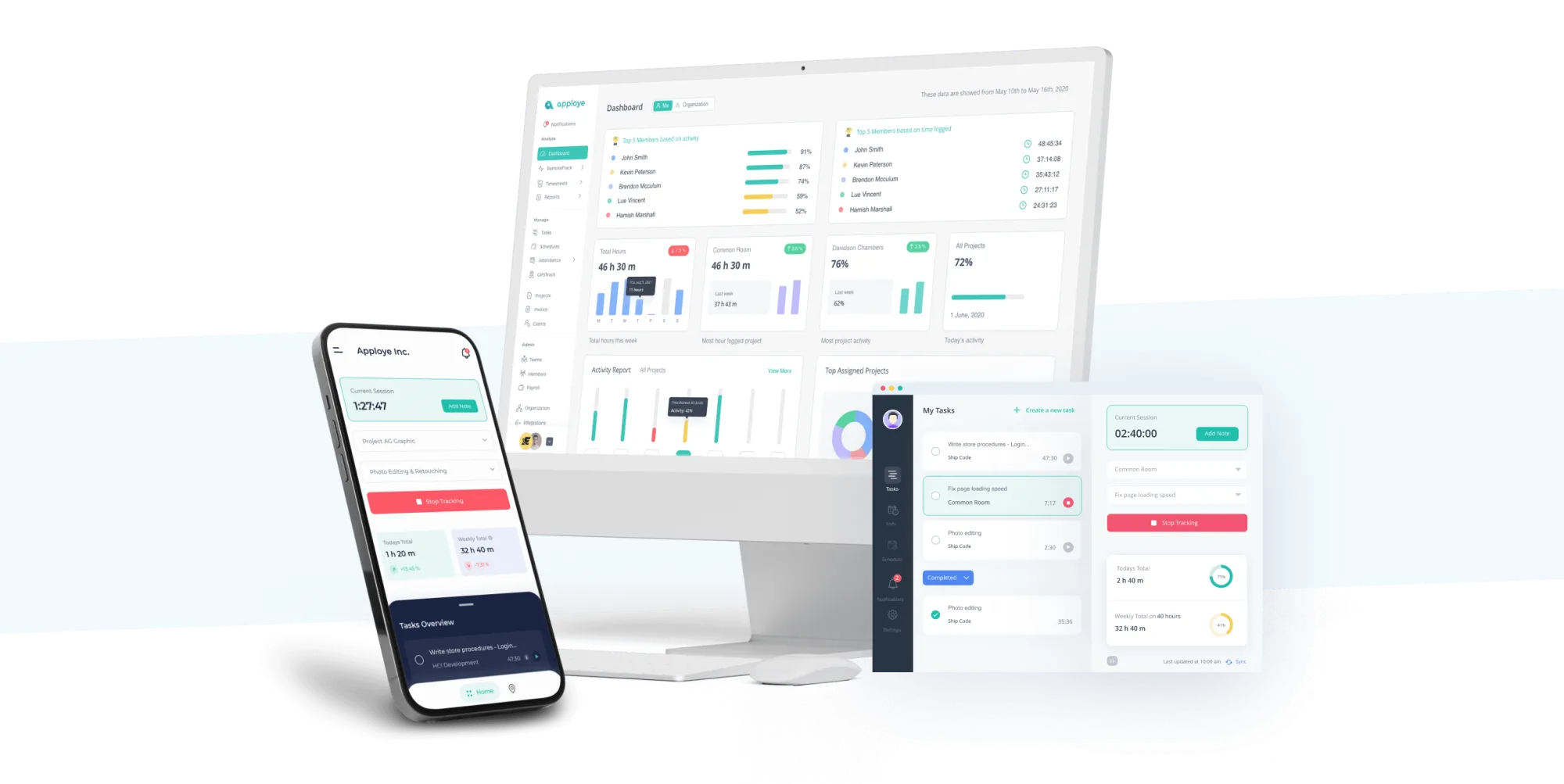Negative Effects of Employee Monitoring & Smart Ways to Avoid Them

Summary:
-
Constant monitoring creates stress and disengagement, with 43% of employees feeling it violates trust rather than improving performance.
-
Employees are 35-40% more productive when given freedom and outcome-based goals instead of being tracked minute by minute.
-
Clear policies, self-management tools, and trust-based tracking lead to happier, more productive teams.
In the era of workplace surveillance, where 96% of all companies use some type of employee monitoring, many believe that it leads to higher employee productivity and efficiency.
However, the reality is far more complex.
In fact, excessive electronic surveillance damages trust, increases worker stress, reduces employee engagement, and can even encourage unethical behavior.
Monitored employees often feel micromanaged, undervalued, and more likely to leave their jobs in search of a healthier work environment, contributing to high-performing workers seeking alternative employment.
This article explores the negative effects of employee tracking systems, from psychological and legal risks to business losses.
Through real-world case studies and expert insights from the field of business and psychology, we’ll uncover why excessive surveillance backfires and how ethical employee monitoring tools can create a more productive, motivated workforce.
In this article:
- How surveillance crushes employee morale and motivation
- Why employee monitoring backfires
- Why watching workers makes them work less
- How over-monitoring can cost companies big time
- Smarter ways to measure productivity
The Psychological Fallout: How Surveillance Kills Engagement
Watching individual employees too much doesn't create better work. Instead, it makes people worried, breaks trust, and leads to bad behavior. They might try to trick the system or just quit their job due to the negative impact on job satisfaction and worker well-being outcomes.
The Micromanagement Paradox
Employers often say they monitor employee computer usage to make them work harder and better.
However, previous studies show that too much electronic monitoring actually does the opposite.
When workers feel like someone is always watching them, they feel less free to work their own way. This leads to more stress, worry, and less interest in their work. Employee work engagement declines significantly due to the disadvantages of employee monitoring.
Research shows that monitored employees are more likely to feel tired and unhappy at their jobs. Instead of focusing on their actual work, these employees spend time trying to look busy.
For example, they might move their computer mouse around or type random things just to seem like they're working hard. This creates records of employee screen activity.
So, even though business owners believe monitoring is supposed to make people work better, it actually makes them unproductive and careless.
The American Psychological Association found that 56% of monitored workers felt stressed at work. On the other hand, only 40% of workers who weren't watched felt the same way.
Balance productivity and trust with Apploye
The "Big Brother" Workplace: How Trust Diminishes
When managers check everything workers do using employee surveillance tools, it changes how people feel at work. Rather than a place where people work together, it becomes a place of fear and lack of trust.
Workers often think that being monitored all the time means their boss doesn’t trust them. This broken trust causes big problems like employee turnover, lower job performance, and even breaking company rules.
Studies show that employees under heavy surveillance are more likely to cheat, take unapproved breaks, or slow down on purpose.
Workers who know that employee tracking systems are monitoring them feel less responsible for their actions. This leads to more bad behavior, like taking office equipment or ignoring instructions.
For example, Amazon's warehouse electronic performance monitoring system tracks every move their workers make using handheld scanners and cameras.
This extreme constant surveillance led to unhappy workers, mental health struggles, and eventually, workers going on strike. The workers felt like they weren't being treated as people, just as numbers, with no care for their health status. [Source: Wired]
Hawthorne Effect vs. Chilling Effect
The Hawthorne Effect and the Chilling Effect are two contrasting behavioral principles that explain the psychological impact of surveillance. Various theoretical models have been developed to understand these effects.
For example, the Hawthorne Effect says that when people know they're being watched, they temporarily improve their performance.
But this doesn't last long and doesn't really make people more productive over time.
The Chilling Effect, however, says that too much monitoring stops workers from trying new things or solving problems in creative ways. That's because they're scared of getting in trouble or afraid of being judged.
Then, they start playing it safe instead of thinking of new ideas. This effect is stronger and lasts much longer than the Hawthorne Effect.
A famous study by psychologist Bernard Nijstad and his team found that being monitored can make people feel more pressure. This makes them focus more on not making mistakes rather than coming up with new and interesting ideas.
Surveillance & Productivity: How Employee Monitoring Declines Output

Watching workers all the time doesn’t make them work harder. Instead, electronic monitoring creates stress and makes people not trust their bosses. Employees spend more company time trying to trick the surveillance systems than doing real work.
Also, companies that overuse employee surveillance tools see more burned-out workers who don’t care about their jobs or even break the rules more often.
Try Apploye's results-focused monitoring
Why Productivity Tracking Backfires
Employee tracking systems ensure that workers are doing their jobs. However, studies show that this actually makes things worse. Workers who know they’re being watched feel more stressed and care less about their work.
Harvard Business Review found that monitored workers were more likely to take browsing breaks, toilet breaks, ignore instructions, and even steal company equipment.
This happens because when people feel someone is always watching them, they stop feeling like they can make their own choices. Then, they start thinking it’s okay to break the rules or cheat the system.
Another problem is that these employee monitoring solutions measure the wrong things.
Many tools only count when someone is clicking or typing, but they miss important things like thinking deeply, planning, or discussing with coworkers. Because of this, workers focus more on looking busy by moving their mouse around or switching between different screens rather than doing actual work.
This shows why tracking employee activity as a sole performance indicator is problematic.
Employees Spend More Time Manipulating Monitoring Tools Rather Than Working
When bosses use strict user activity tracking systems, employees look for ways to trick them instead of focusing on their actual jobs. Reports show that some workers in heavily watched jobs spend a lot of time trying to fool the employee surveillance tools.
For example, 25% of workers use programs that move their mouse automatically or put things on their keyboard to make it look like they’re working.
This shows why direct effects of over-monitoring don’t work. Rather than making sure people work hard, it makes them come up with sneaky ways to look busy.
On top of that, these user activity reports can make employees work in inefficient ways. Instead of finishing tasks quickly, workers might spread their work out over a longer time to look like they’re always busy.
Case Study: Time Tracking Backfired with Legal Consequences
Topgolf used a finger-scan system to check when workers came and left. They also checked how much work people did.
Later on, employees sued the company because of the Illinois Biometric Information Privacy Act.
This shows the legal dangers of watching workers too much. Simple time-tracking can end up with the company in big trouble if they don't follow the rules.
Stay compliant with Apploye's legal tracking
Surveillance's Impact on Remote Work Culture
Remote workers are actually 35-40% more productive than office workers because they have fewer distractions at home. However, they can waste time too, with studies showing that up to 30% of work time is spent on personal devices.
Since more people started working from home, employee monitoring software has become popular. Now, over 78% of companies are tracking what their workers do in remote workplaces.
However, this widespread surveillance has made workers feel worse and less like they like their jobs. Many experience negative outcomes, such as feeling like they’re in a "digital prison."
Forbes has found that 31% of monitored employees feel micromanaged, and 23% feel they are under constant surveillance.
This leads to lower worker autonomy, less trust in bosses, and even more employee turnover as individuals seek jobs where they feel respected.
Also, research suggests that too much watching leads to people caring less about their work, not more. Workers who feel constantly watched are more likely to put in less effort, fight against company goals, and start to see management as the enemy.
As you can see, the direct association between excessive surveillance and decreased morale is clear.
Case Study: Why Some Companies Are Ditching Productivity Monitoring for Outcome-Based Evaluations
People are pushing back against excessive monitoring. That's why some companies have switched from tracking activities to looking at outcomes.
Rather than focusing on how many hours workers spend on their computers, these companies look at what actually gets done, what goals are met, and how much each person contributes.
This process makes workers happier and more engaged. And they actually got more done because they focused on results rather than just looking busy.
Similarly, big tech companies like Google and Apple don't use extreme monitoring tactics. They know that trusting workers and giving them flexibility leads to more new ideas and happier employees.
Switch to Apploye's outcome-based approach
The Legal & Ethical Risks of Excessive Employee Monitoring

Watching workers too much can get companies in legal trouble and raise questions about what’s right and wrong.
The Legal Grey Area: Where Employee Monitoring Crosses the Line
Organizations walk a fine line when they closely observe their workers. Different places have different monitoring laws. Many bosses say they need to keep an eye on things for safety and to boost productivity.
However, privacy rights and expectations of privacy put limits on how they can collect, keep, and use employee info.
Organizations that fail to consider the expectation of privacy or adhere to laws like GDPR, CCPA, or HIPAA may face lawsuits and regulatory penalties.
General Data Protection Regulation (GDPR) in the EU
In Europe, GDPR says employers must ask workers before monitoring them. The surveillance must not go beyond what the company needs. Workers can see what info managers collect about them and ask to delete it when it's not needed anymore.
California Consumer Privacy Act (CCPA) in the U.S.
CCPA extends privacy rights to employees. This law requires that companies must tell workers what info they collect, how they use it, and who sees it. Employees can say no to their personal info being sold.
This matters a lot in industries where monitoring tools track browsing history, keystrokes, and even biometric data from wearable devices.
Health Insurance Portability and Accountability Act (HIPAA)
HIPAA keeps workers' health info safe. Bosses can't collect or share health data without asking first. But some companies use monitoring tools that track heartbeats, stress, and health stats. This could break HIPAA rules if not done right.
Even with these protections, many organizations ignore the rules or try to find loopholes. They often think workers won't know enough or have the money to fight back.
However, the risk of being sued, paying fines, and reputational damage keeps growing as more employees push back against too much surveillance.
Case Study: An $8.5 Million Data Breach Due to Lack of Monitoring
In late 2022, Gunster found that someone had snuck into their computer network. This break-in put the personal and health info of nearly 10,000 people at risk.
The company acted fast. They fixed the network and added more safety to stop future problems.
But they still ended up paying $8.5 million to settle a lawsuit about the data breach. This shows how serious these safety issues can be. [Source: Reuters]
Stay within legal boundaries using Apploye
Cybersecurity Risks & Data Breaches
Organizations implement employee monitoring software to enhance security. But these systems often create new weak spots that put sensitive employee and company data at risk of falling into the wrong hands.
Weak Security Protocols Make Monitoring Tools a Target
Many monitoring programs keep lots of personal worker info (like what keys you press, what you search for, and login details). If these systems lack strong encryption or multi-factor authentication, they become prime targets for hackers.
Cybercriminals can use surveillance tools to get into company networks without permission. This turns inside monitoring into outside data leaks.
Employee Data Is at Risk of Unauthorized Access
Without proper access controls or monitoring logs, emails, chats, and private business deals might be seen by unauthorized personnel. This increases internal data leak risks.
Workers often don't know who has access to their monitored info. This leads to worries about misuse, unfair treatment, or threats in the workplace.
A clear workplace monitoring policy is essential to address these concerns.
Case Study: Uber's Data Breaches and Monitoring Practices
Uber had several data leaks that showed the private information of both employees and drivers.
In 2014, a leak showed the names and license plates of about 50,000 drivers. In 2016, another leak showed the personal info of 600,000 drivers and 57 million customers.
These problems showed vulnerabilities in data storage and access controls.
Also, Uber faced criticism for its internal monitoring practices. It included the "God View" tool. It lets workers track where customers were without asking them first.
The Business Risks: Why Employee Monitoring is a Costly Gamble

Watching your workers might seem like a good idea to make them work harder. But it's actually a bad bet that can cost your business a lot! From workers quitting to making your company look bad, there are big problems with too much monitoring.
1. High Turnover Rates Due to Employee Distrust
When you over-monitor employees, they stop trusting you. This makes them want to quit. That's because people hate feeling like someone is always looking over their shoulder.
- Surveillance Fuels Workplace Anxiety: 56% of watched workers felt stressed, and 43% feel surveillance is a violation of trust.
- Workers Leave Micromanaged Environments: Employees who are tracked too closely often look for jobs where they feel more respected.
- Loss of Morale & Productivity Decline: When people think you don't trust them, they don't work as hard. So checking on them all the time can actually make them do worse!
When workers feel like they're just pieces in a machine instead of valued team members, they'll find somewhere else to work. Many choose companies that give them freedom and trust.
Reduce turnover with Apploye's monitoring
2. Negative Employer Brand & Hiring Challenges
Organizations known for excessive employee monitoring get a bad name. This makes it super hard to hire good people or retain top talent.
● Surveillance Fuels Workplace Anxiety: Morning Consult survey found that more than half of tech workers would quit rather than work somewhere that records them with cameras, microphones, or face scanners.
- Loss of Competitive Edge in Hiring: Candidates, particularly younger workers, prioritize workplace culture and transparency. But, trust between bosses and workers is really low these days. This makes it harder to get the best people if your company is known for aggressive surveillance.
- High-Profile Companies Reject Extreme Monitoring: Places like Apple and Google don't use invasive tracking. They know that trusting workers makes them happier and more loyal.
To get a good name as an employer, you need to make workers feel respected, not spy on them. Companies that don't get this have big problems finding and keeping good people.
3. Surveillance Tech Can Be Expensive & Ineffective
Even though companies sell tracking tools by saying they make workers more productive, many don't actually help. Despite promises of tangible benefits, the cons of employee monitoring often outweigh the advantages of employee monitoring.
Of course, this isn't true for the best employee time tracking software.
Organizations spend tons of money on tracking systems. However, employees just find ways around them, waste office time in other ways, or fake their activity.
Also, counting keystrokes or screen time doesn't show deep work, creativity, and problem-solving tasks. These can't be measured by surveillance systems.
Instead of creating a more productive workforce, excessive tracking often leads to more stress and disengagement. To cope with this, employees sometimes falsify activity logs or "game" the system.
Get affordable, effective tracking with Apploye
Ethical Alternatives to Employee Monitoring
When companies move from electronic monitoring to an effective employee monitoring strategy based on trust and transparency, everyone wins. Workers feel better, get more done, and stay at their jobs longer.
Rather than relying on internet usage & online activities monitoring, organizations should focus on worker well-being outcomes and long-term positive outcomes and long-term positive association.
Shift from Time-Based to Outcome-Based Performance Metrics
Traditional employee monitoring tools focus on "active time" instead of what employees actually do. This leads to counterproductive behaviors like excessive micromanagement, employee burnout, and even intentional rule-breaking.
A better way is to look at what tasks workers have completed, not how long they sit at their desk or how many keys they press.
Research shows that excessive monitoring makes employees feel like no one trusts them. This leads to disengagement and lower performance.
Instead, companies should focus on key performance indicators (KPIs) and measurable goals for performance reviews and avoid minute-by-minute tracking. This will give you higher levels of job satisfaction and productivity.
For instance, some organizations now let workers decide when to do their tasks. They give clear goals but let workers choose how to reach them. This way, people can work when they feel most awake and ready, not just when the clock says so.
Encourage Transparency Over Covert Tracking
One big reason why employee monitoring fails is that companies don't tell them how, when, or why they're being watched. Workers who think they're being spied on feel more stress, don't trust their employers, and sometimes even do things that hurt the company.
So, the consequences of workplace surveillance and the consequences for workers should be carefully considered.
Case Study: Douglas Academy Improved Productivity by 28% with Apploye

Douglas Academy teaches kids about robots and coding in Canada. They had a hard time keeping track of their teachers because many worked online or at different schools. They trusted their staff but couldn't check if teachers showed up or taught well.
So, Mohammad D., who runs operations, started using Apploye's time tracker. It helped by:
- Keeping track of when teachers worked without anyone having to do it by hand.
- Taking pictures of online classes now and then to see if the teaching was good.
- Seeing how much work teachers got done to make sure everyone was being used well.
The results were amazing. In less than a year, they got 28% more productive! The school did more work while still keeping the teachers' trust.
This shows that fair checking helps everyone do what they should without making them feel watched all the time.
Try Apploye's ethical monitoring approach
Empowering Employees with Self-Management Tools
Instead of bosses watching from above, companies can give workers tools to check their own work without hurting their privacy.
Studies show that employees who control their own way of working feel less stress and stay more interested in their jobs, especially when using company-owned devices or company-provided equipment.
Why Giving Employees Autonomy Works Better
- Workers who feel trusted don't try to cheat the system as much as those who think their boss is always looking over their shoulder.
- When people check themselves, they want to grow and get better without being scared of getting in trouble.
- Instead of watching every move, teaching and helping programs can make employees better.
Conclusion: Trust Drives Success (Not Surveillance)
As you can see, excessive employee surveillance tools create more harm than good. It can lower trust, increase employee turnover, and damage a company’s reputation.
So, instead of relying on intrusive tracking, organizations should shift toward an effective employee monitoring strategy, worker autonomy, and a positive association with employee productivity.
The most successful workplaces are built on trust, not fear.
By prioritizing respect and worker well-being, businesses can create a culture where employees feel valued, engaged, and motivated to perform at their best, without the need for constant monitoring.
Build a culture of trust with Apploye today

